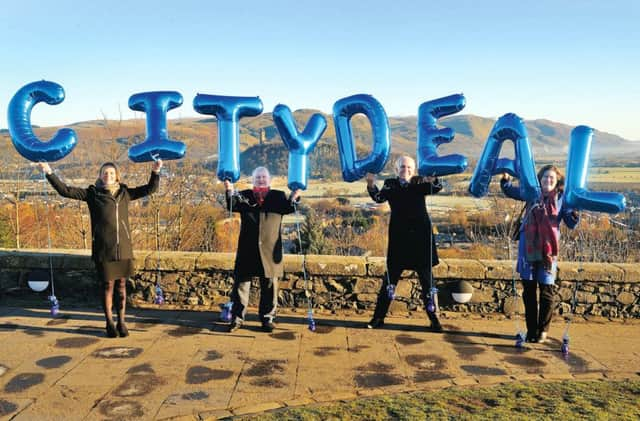Stirling puts social innovation at heart of City Deal


Taking in Clackmannanshire as well as Stirling itself, the City Deal will give the area greater powers to help support economic growth.
A new civic harbour quarter and a city park in the shadow of Stirling Castle are among the plans to breathe new life into the region.
Advertisement
Hide AdAdvertisement
Hide Ad“This is truly a once-in-a-generation opportunity for Stirling and the surrounding areas to really grow our economy, not just for the benefit of Stirling but nationally and internationally,” says Stirling Council leader Johanna Boyd.
“We have been very clear that not only do we want to really make an impact in economic terms, we also want to take action to tackle poverty and inequality that exists in some of our communities.”
A list of infrastructure projects sets out the big ideas to develop Stirling as a place to do business but Boyd says there’s more to it than developing an entrepreneurial ecosystem.
“It’s not just about buildings, it’s also about people,” she explains. “We want programmes of change to get people into work and we have been very clear that we want social innovation to sit at the heart of the City Deal.”
It was Stirling’s unique approach to its City Deal bid that has seen it leapfrog other Scottish cities to be top of the pile for the funding.
“We already have a lot to offer in terms of quality of environment and schooling,” says Boyd. “This is about deciding what’s great about Stirling and pushing it forward.
“We want to be seen as bold, dynamic, collaborative, partner-focused, very much as a place that welcomes innovation but also we want to be seen as being very socially and civic minded.”
It’s a city where unemployment is a live issue – in some areas male unemployment can be as high as 30 to 40 per cent.
Advertisement
Hide AdAdvertisement
Hide AdYet it is also home to Stirling University, which is a leader in sports development, research and science, as well as Forth Valley College and a number of large, international employers including Prudential and Standard Life.
Its location and transport links make Stirling a desirable and accessible place to set up shop and it’s certainly attracting attention from some of Scotland’s big tech and third sector players. CodeBase – the UK’s largest technology incubator – is branching out from its Edinburgh home with a new facility due to open in Stirling this year.
“We are absolutely delighted to have secured a name like CodeBase here in Stirling,” says Boyd.
The Robertson Trust, currently based in Glasgow, is putting down roots in Stirling and will create space for third-sector organisations to come together under one roof.
“We think that’s going to be innovative in how those third-sector organisations relate to one another and support one another.”
Organisations and initiatives such as Made in Stirling and Scotland’s Towns Partnership (STP) are working hard to ensure people come into the city centre and support local businesses.
Made in Stirling offers local designers, makers and artists the opportunity to sell their work on the high street, while STP is the “go-to” body for towns across Scotland.
But much of Stirling’s business goes on outside the city bounds. “The rural economy is key for us here in Stirling and it’s important to emphasis that it’s a city region deal,” says Boyd.
Advertisement
Hide AdAdvertisement
Hide Ad“Another idea that we have been very alive to is how we get rural produce and products into the city so we are selling all of Stirling, not just the aspects that are very familiar to people like the castle and the Wallace Monument.
“Nearly half a million visitors come to Stirling Castle each year so we are looking at how we get them to spend more time in Stirling.”
Urban facts
Population
The Stirling Council area has a population of 92,830 (June 2016).
Employment
The top three sectors for employment in Stirling are public, admin, education and health (28 per cent), financial and other business services (21 per cent) and wholesale and retail including motor trades (18 per cent).
Earnings
The gross weekly full-time median earnings for employees living and working in the Stirling area is £504, according to NOMIS – National Statistics (January 2016).
Tourism
There were 4 million visitors to Stirling in 2014. The total economic impact of tourism in Stirling in 2014 was £463m, with 9,201 jobs supported in the industry.
Education
There are seven secondary schools in the Stirling Council area.
University
Stirling University has more than 9,450 undergraduate students, 3,390 postgraduate students, employs more than 1,500 members of staff and has over 120 nationalities represented on campus. It is ranked 38 in the United Kingdom by the Times Higher Education Best Universities in the UK.
Construction projects
Advertisement
Hide AdAdvertisement
Hide Ad– A £6m development of 53 affordable homes opened on Goosecroft Road, Stirling in June 2016.
– Construction of a £35m care village at Stirling Community Hospital started in January. The majority of facilities are expected to be open by autumn 2018.
– Last summer, Stirling Council approved a 400-home expansion of Raploch in an effort to accelerate work to tackle disadvantage and deprivation in the area.
This article appears in the SPRING 2017 edition of Vision Scotland. An online version can be read here. Further information about Vision Scotland here.